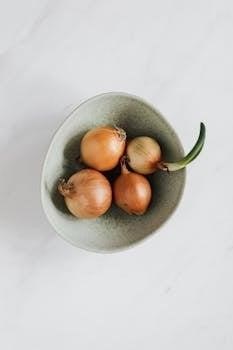aroma vegetable steamer instructions
This guide will walk you through using your Aroma vegetable steamer, ensuring you achieve perfectly cooked vegetables every time․ It covers all the essential steps, from setup to maintenance, so you can enjoy healthy meals effortlessly․ Remember to read all instructions carefully before first use․
Initial Setup and Safety Precautions

Before using your Aroma vegetable steamer for the first time, carefully unpack all components and ensure they are free from any damage․ Read the entire instruction manual thoroughly to familiarize yourself with all the features and safety guidelines․ Place the steamer on a level, dry, and heat-resistant surface, away from any flammable materials․ Ensure that the power cord is not damaged and is properly plugged into a functioning outlet․ Always use the handles or knobs when handling the steamer to avoid burns, as surfaces can become very hot during operation․ Never immerse the base of the steamer in water or any other liquid․ Keep the appliance away from the reach of children and pets․ Be aware that the temperature for fruit and vegetables shall not exceed 63 degrees to avoid destroying the vitamins․ Always ensure the inner cooking pot is dry and free of debris before placing it into the rice cooker․ This will help prevent issues and ensure it operates correctly․ The steamer is designed for indoor use only and not for commercial purposes․ Finally, make sure the appliance is turned off and unplugged before cleaning․
Understanding the Control Panel
The Aroma vegetable steamer’s control panel is designed for easy and intuitive use․ Typically, it features a power button to turn the device on and off․ Look for a timer dial or digital buttons to set your desired steaming time; this is crucial for cooking different vegetables to perfection․ Many models have a “keep warm” function, which automatically activates once the steaming cycle is complete, keeping your vegetables warm until serving․ The delay timer button is also included on some models․ Some control panels may also include a “steam” function button, which allows the selection of the appropriate time for steaming․ The control panel might also show indicator lights, like a “power on” light and a “cooking” light, to visually indicate the current status․ Certain advanced models may have pre-programmed settings for specific types of food․ It’s important to consult your specific model’s manual for a complete understanding of all the functions and options available on the control panel․ Remember, familiarity with the control panel will make your steaming process easier and more efficient․
Steaming Vegetables⁚ A General Guide
Steaming is a healthy and efficient way to cook vegetables, preserving their nutrients and natural flavors․ Begin by adding the appropriate amount of water to the steamer’s base, according to the manufacturer’s recommendations․ Next, arrange your prepared vegetables in the steaming tray, ensuring they are evenly distributed for consistent cooking․ Avoid overcrowding the tray, which can lead to uneven steaming․ Set the timer based on the type and quantity of vegetables you are preparing, consulting the recommended steaming times for each vegetable․ When steaming, the lid should be securely placed on the steamer to allow for proper steam circulation․ Once the timer is complete, carefully check the vegetables for desired tenderness․ It’s best to start with a shorter steaming time and add more time if needed․ Remember to use caution when opening the steamer, as steam will be released․ Use oven mitts or pot holders to protect your hands․ Enjoy your perfectly steamed vegetables!
Specific Vegetable Steaming Times
Achieving perfectly steamed vegetables relies on knowing the correct cooking times․ For asparagus, a recommended steaming time is around 20 minutes, ensuring it’s tender yet slightly firm․ Broccoli florets typically require about 15 minutes, or until they are bright green and easily pierced with a fork․ Carrots, whether sliced or whole, usually need approximately 25 minutes, or until they reach your preferred level of tenderness․ Other common vegetables, such as cabbage and cauliflower, also require 25 minutes for optimal steaming․ Green beans should be steamed for around 15 minutes․ Peas, on the other hand, generally need around 20 minutes․ These are general guidelines; always check for doneness and adjust times according to your preference and the size of the vegetables․ Remember that these times may vary depending on the model of your steamer and the desired texture of the cooked vegetables․ These are just starting points․
Asparagus
For perfectly steamed asparagus, aim for approximately 20 minutes of steaming time․ This duration typically results in tender stalks that still retain a slight firmness, avoiding a mushy texture․ The thickness of the asparagus spears can influence the exact time needed; thicker spears may require a few extra minutes․ To prepare, wash the asparagus thoroughly and trim the tough ends․ Arrange the spears in the steamer tray, ensuring they are spread evenly to promote consistent steaming․ Check for doneness by piercing the thickest part of a spear with a fork; it should slide in easily but not be overly soft․ If you prefer a more tender texture, add another minute or two to the steaming time․ It is always better to start with less time and then add more as needed to avoid overcooking․ Remember, fresh asparagus is best enjoyed when it’s cooked just right․
Broccoli

Steaming broccoli in your Aroma steamer is simple and efficient, yielding vibrantly green and tender-crisp florets․ A recommended steaming time is around 15 minutes, which typically results in the ideal texture․ Prior to steaming, ensure that the broccoli is cut into uniformly sized florets for even cooking․ Wash the florets thoroughly to remove any dirt․ Arrange the broccoli pieces in a single layer in the steamer basket․ Avoid overcrowding to ensure all florets are exposed to the steam adequately․ Check for doneness by poking a floret with a fork; it should be easily pierced but still have a slight resistance․ If you prefer your broccoli softer, you can add an extra minute or two to the steaming time․ Remember, the goal is to achieve broccoli that is cooked through but not mushy․ Monitor carefully to avoid overcooking and enjoy the healthy benefits of perfectly steamed broccoli․
Carrots
For steaming carrots in your Aroma steamer, you’ll want to prepare them appropriately for the best results․ Begin by washing and peeling your carrots․ Cut them into uniform pieces, whether slices, sticks, or coins; this ensures even cooking․ A typical steaming time for carrots is about 25 minutes, but this might vary slightly depending on the thickness of your cuts and your desired level of tenderness․ Place the cut carrots in the steamer basket, making sure they are not overcrowded․ Overlapping pieces may not steam evenly․ The carrots are ready when they are easily pierced with a fork, yet still have a slight firmness․ If you prefer them softer, you can extend the steaming time․ Monitor the carrots closely during the steaming process to prevent them from becoming too mushy․ Steamed carrots retain their natural sweetness and are a healthy and convenient side dish․ Feel free to adjust the time to suit your preference․
Other Common Vegetables
Beyond asparagus, broccoli, and carrots, your Aroma steamer is perfect for a wide variety of other common vegetables․ Green beans, for instance, typically require about 15 minutes of steaming for a tender-crisp result․ Peas are best steamed for around 20 minutes, maintaining their sweetness and vibrant color․ Corn on the cob, a summer favorite, can be steamed for approximately 25 minutes․ Cauliflower, like broccoli, also steams well in about 25 minutes․ Cabbage needs a bit longer, about 25 minutes as well, to become tender․ Spinach steams very quickly, often in just a few minutes, so keep a close eye on it․ Eggplant is another option, usually needing around 20-25 minutes for a soft texture․ Zucchini and squash steam quickly as well, usually within 15-20 minutes․ Remember to cut all vegetables into similarly sized pieces for even cooking․ The times provided are a general guideline; adjust them to your liking for preferred texture․
Using the Steamer with a Rice Cooker
Many Aroma rice cookers come with a convenient steaming tray, allowing you to steam vegetables while simultaneously cooking rice․ This feature is great for preparing complete meals with minimal effort․ To use this function, first, prepare your rice as you normally would in the inner pot․ Then, place the steaming tray on top of the rice pot․ Add your vegetables to the steaming tray, ensuring they are cut into uniform sizes for even cooking․ Place the lid on the rice cooker and initiate the cooking cycle․ The steam generated from the rice cooking process will cook the vegetables above it․ Be aware that cooking times for both rice and vegetables might need slight adjustments depending on the quantity and type of vegetables․ Usually, the rice will cook first, and the unit will switch to “keep warm” mode․ Check the vegetables at this point to see if they are cooked to your liking․ If not, you may need to continue steaming for a few more minutes․ Always refer to your rice cooker’s manual for specific guidelines․

Water Level Guidelines for Steaming
Maintaining the correct water level is crucial for efficient and safe steaming with your Aroma vegetable steamer․ Insufficient water can lead to the steamer running dry, potentially damaging the appliance and not cooking your food properly․ Too much water, on the other hand, can cause boiling over and create a mess․ Always fill the base reservoir with the amount of water recommended in your steamer’s manual․ Typically, a guideline is to add enough water to reach the designated fill line․ This often varies depending on whether you are using a single or multiple tiers․ If steaming for an extended period, especially for foods requiring longer cooking times, check the water level periodically and add more if necessary․ It’s best to use cold, filtered water to avoid mineral buildup․ Avoid using hot water to begin with, as this can affect the steaming process․ Remember that most vegetables absorb only a small amount of water during steaming, so you don’t need to drastically increase the water level, even if cooking a large quantity of vegetables․ Always consult your specific model’s instructions for precise measurements․
Cleaning and Maintenance Tips
Proper cleaning and maintenance are essential to prolong the life of your Aroma vegetable steamer and ensure its optimal performance․ Always unplug the steamer and allow it to cool completely before cleaning․ The base unit, which contains the heating element, should never be submerged in water․ Instead, wipe it down with a damp cloth․ The steaming trays, lids, and any other removable plastic parts can usually be washed in warm, soapy water or placed in the dishwasher if they are designated as dishwasher-safe, as most are․ Avoid using abrasive cleaners or scouring pads, as these can damage the surfaces․ Pay particular attention to cleaning the water reservoir, as mineral deposits can accumulate over time․ To remove these deposits, you can use a solution of equal parts white vinegar and water, letting it sit for a short time before rinsing thoroughly․ Make sure all parts are completely dry before reassembling and storing your steamer․ Regular cleaning and proper maintenance will help prevent any issues and ensure that your Aroma steamer continues to perform efficiently for years to come․

Troubleshooting Common Issues
If your Aroma vegetable steamer is not functioning correctly, there are several troubleshooting steps you can take before seeking professional help․ If the steamer does not turn on, first, ensure that it is properly plugged into a working power outlet․ Check the power cord for any damage․ If the steamer powers on but does not produce steam, verify that there is enough water in the reservoir․ The water level should be within the recommended range․ If the food is not cooking evenly, make sure the vegetables are cut into uniform sizes and are not overcrowded in the steaming tray․ Overcrowding can inhibit proper steam circulation․ If you notice an unusual odor, thoroughly clean all the components, including the water reservoir, as described in the cleaning section․ If the timer or auto shut-off functions fail, consult your user manual for specific reset instructions․ If the problem persists after these steps, contact Aroma customer service or check their website for further assistance․ Regular maintenance can prevent many common issues․ Additionally, always read the instruction manual․
Leave a Reply